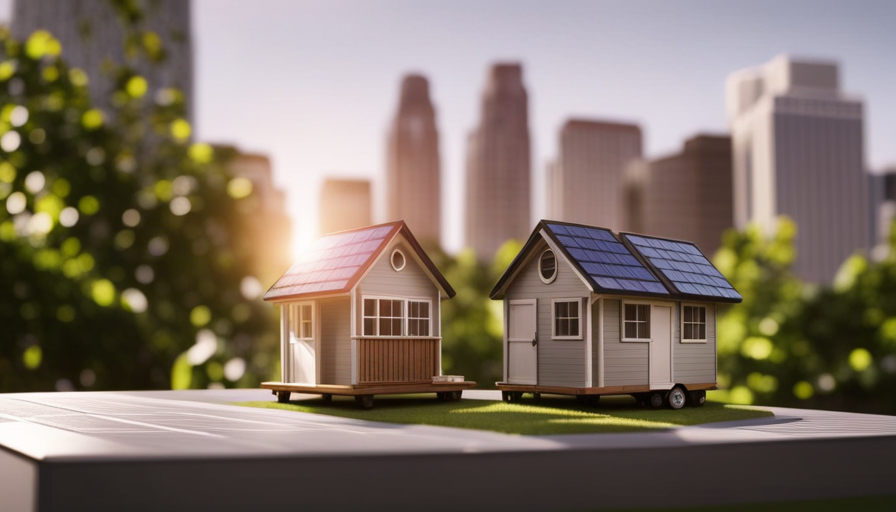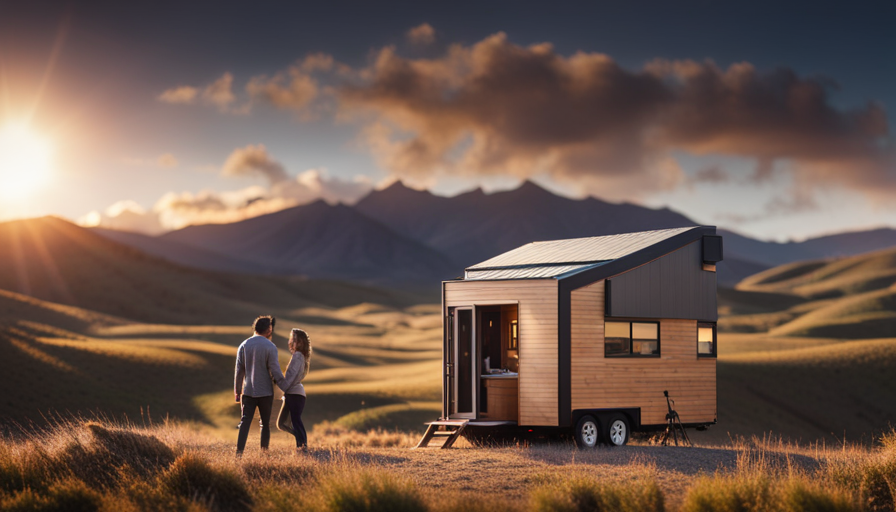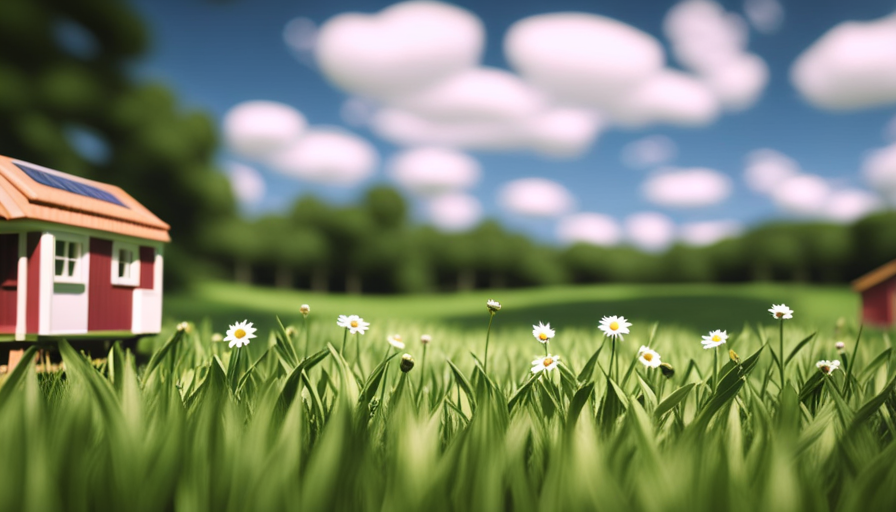As the familiar saying goes, “Weight is not just a number; it plays a crucial role in the building of tiny homes.” In the world of constructing tiny homes, the significance of each pound cannot be emphasized enough. Weight has a significant impact on aspects such as structural soundness, mobility, and the ability to live off the grid in these compact dwellings. It is a crucial factor to consider in both the design and functionality of these small residences.
In this article, I will delve into the importance of weight in tiny house construction, particularly focusing on a specific size: 680 sqft. By understanding the structural elements and factors that contribute to the weight of a tiny house, we can estimate how much a 680 sqft tiny house would weigh.
Additionally, I will explore how weight affects transportation, mobility, and even zoning and building codes.
Furthermore, I will provide tips on reducing the weight of a tiny house, ensuring it remains both practical and sustainable.
Join me as we explore the world of tiny houses and uncover the secrets behind their weight considerations.
Key Takeaways
- Weight in tiny house construction is influenced by structural materials, insulation, weather conditions, and interior furnishings.
- The average weight per square foot of a tiny house ranges from 20 to 30 pounds, with framing, insulation, siding, roofing, and flooring all contributing.
- Choosing lightweight materials for furnishings and appliances, as well as maintaining balance and stability, can improve energy efficiency.
- Understanding and adhering to weight restrictions in zoning and building codes is crucial for safety, obtaining permits, and passing inspections.
The Importance of Weight in Tiny House Construction
You’ll be amazed at how crucial weight is when it comes to building your tiny house! Calculating the weight of your tiny house is a critical step in the construction process. Every material and component you choose will have an impact on the overall weight of your structure. From the foundation to the roof, each element must be carefully considered to ensure the tiny house remains structurally sound.
To calculate the weight of your tiny house, you’ll need to consider the weight of the materials used for the walls, floors, and roof. For example, if you choose to use wooden framing, you’ll need to calculate the weight of the lumber, insulation, and any additional materials used. Additionally, you’ll need to account for the weight of the windows, doors, appliances, and furniture that will be inside your tiny house.
Understanding the impact of weight is crucial because it affects not only the structural integrity of your tiny house but also its mobility. Excessive weight can put stress on the foundation, causing it to buckle or crack. It can also make towing or transporting your tiny house more challenging. Therefore, it’s essential to carefully consider the weight of each component and ensure that it aligns with the overall design and intended use of your tiny house.
With a solid understanding of the importance of weight, let’s move on to understanding the structural elements of a tiny house.
Understanding the Structural Elements of a Tiny House
To grasp the structure of a tiny house, take a closer look at its various elements and how they come together. One key aspect to consider is weight distribution, as it directly impacts the overall stability of the house and its foundation. Understanding the structural elements of a tiny house is crucial for ensuring its longevity and safety.
In order to illustrate this point, let’s examine a table that outlines the main components of a typical tiny house and their respective weights:
| Structural Element | Weight (lbs) |
|---|---|
| Foundation | 8,000 |
| Frame | 3,500 |
| Walls | 2,000 |
| Roof | 1,500 |
As you can see, the foundation carries the greatest amount of weight, followed by the frame, walls, and roof. This distribution ensures that the weight is evenly distributed and properly supported by the foundation.
The weight distribution in a tiny house is critical because it affects the overall stability and durability of the structure. If the weight is not properly distributed, it can lead to uneven settling, which can cause structural damage to the foundation over time.
Understanding the structural elements and weight distribution of a tiny house is just one piece of the puzzle. In the next section, we will explore the factors that contribute to the weight of a tiny house, further delving into its construction and design.
Factors that Contribute to the Weight of a Tiny House
If you’re curious about what makes a tiny house heavy, consider the factors that contribute to its weight. Understanding these factors can help you make informed decisions when designing and building your own tiny house. Here are four key factors that have a significant impact on the weight of a tiny house:
-
Structural Materials: The choice of materials used in the construction of a tiny house can greatly affect its weight. For example, using heavy-duty steel framing will add more weight compared to using lightweight wood framing.
-
Insulation: Insulation is essential for maintaining a comfortable interior temperature in a tiny house. However, insulation materials such as fiberglass or spray foam can add weight to the overall structure.
-
Weather Conditions: The impact of weather on a tiny house can also affect its weight. For instance, if the tiny house is exposed to heavy rain or snow, the moisture absorbed by the materials can significantly increase the weight.
-
Interior Furnishings: The weight of the furniture, appliances, and personal belongings inside the tiny house can quickly add up. It’s important to carefully consider the weight of each item to ensure the overall weight of the tiny house remains manageable.
Considering these factors, estimating the weight of a 680 sqft tiny house can be a complex task.
Estimating the Weight of a 680 sqft Tiny House
When estimating the weight of a 680 sqft tiny house, there are several key factors to consider. Firstly, the average weight per square foot is crucial in determining the overall weight of the structure.
Secondly, calculating the weight of materials used in construction, such as wood, metal, and insulation, is essential for an accurate estimation.
Lastly, it’s important to account for the weight of furnishings and appliances that’ll be installed in the tiny house, as this can significantly add to the overall weight.
By taking into account these factors, a precise estimation of the weight of a 680 sqft tiny house can be achieved.
Average weight per square foot
The average weight per square foot of a tiny house is a crucial factor to consider when determining how much a 680 sqft tiny house would weigh. The weight distribution of the materials used in the construction impacts the overall weight of the house.
Typically, the average weight per square foot of a tiny house ranges from 20 to 30 pounds. However, this can vary depending on the type of materials used. For example, if lightweight materials such as aluminum or fiberglass are used, the weight per square foot may be lower. Conversely, if heavier materials like wood or concrete are used, the weight per square foot may be higher.
Calculating the weight of materials is essential in accurately estimating the total weight of a 680 sqft tiny house.
Calculating the weight of materials
When it comes to determining the weight of a tiny house, calculating the weight of materials is a crucial step. By analyzing weight distribution, we can estimate the overall weight of the house accurately. To do this, we need to consider the weight of various components such as the framing, insulation, siding, roofing, and flooring. Each material has its own weight per square foot, and adding them up will give us the total weight of the house. To help visualize this process, I have created a table below:
| Material | Weight per Square Foot (lbs) |
|---|---|
| Framing | 10 |
| Insulation | 2 |
| Siding | 4 |
| Roofing | 3 |
| Flooring | 5 |
Analyzing the weight distribution based on these values will give us a better understanding of the overall weight of a 680 sqft tiny house. Now that we have calculated the material costs, we can move on to adding the weight of furnishings and appliances.
Adding the weight of furnishings and appliances
To accurately estimate the weight of your furnishings and appliances, you can consider the weight distribution of each item and add them up accordingly. Factors affecting weight distribution include the location of the item within the tiny house, the size and material of the item, and the support structure it rests on.
It’s important to note that the weight distribution of furnishings and appliances can have a significant impact on the energy efficiency of the tiny house. For example, placing heavier items towards the center of the house can help maintain balance and stability, which can improve the overall energy efficiency of the structure. In addition, using lightweight materials for furnishings and appliances can help reduce the overall weight of the tiny house.
Taking these factors into account, you can calculate the weight of your furnishings and appliances to ensure optimal weight distribution and energy efficiency.
Transitioning into the subsequent section about how weight affects transportation and mobility, understanding the weight distribution of your tiny house is crucial for ensuring safe and efficient transportation.
How Weight Affects Transportation and Mobility
When it comes to transporting a tiny house, there are several key factors to consider. First, it’s crucial to choose the right trailer or foundation. This is important in ensuring stability and safety during transportation. Additionally, it’s important to be aware of legal weight limits for towing. This will help avoid any potential fines or accidents. Lastly, the weight of the tiny house directly impacts its mobility and portability. Therefore, it’s necessary to carefully consider the weight distribution and overall weight of the structure.
Choosing the right trailer or foundation
Finding the perfect trailer or foundation for your tiny house is crucial, as it’ll determine the overall weight and stability of your dream home. When considering trailer options, it’s important to choose one that’s specifically designed for tiny houses. Look for trailers that have reinforced frames and axles capable of supporting the weight of your house.
Additionally, consider the length and width of the trailer to ensure it can accommodate your tiny house dimensions. When it comes to foundation types, there are a few options to consider. Some popular choices include traditional foundations, such as concrete slabs or crawl spaces, or more innovative options like trailer-mounted foundations. These foundations offer mobility and flexibility, allowing you to easily move your tiny house if needed.
Transitioning into the discussion about legal weight limits for towing, it’s essential to ensure that your chosen trailer or foundation complies with these regulations.
Legal weight limits for towing
When choosing the right trailer or foundation for a tiny house, it’s crucial to consider the legal weight limits for towing. These limits vary depending on the country, state, and even the specific road you plan to travel on. Exceeding these limits can result in fines, penalties, and even damage to your vehicle or the road itself.
To determine the legal weight limits for towing, you need to know your vehicle’s towing capacity and the weight of your tiny house. Towing capacity refers to the maximum weight your vehicle can safely tow. It’s essential to stay within this limit to ensure a safe and smooth journey.
By adhering to legal weight limits and considering your vehicle’s towing capacity, you can confidently embark on your tiny house adventure without compromising safety or legality.
Transitioning into the subsequent section, it’s essential to understand how these weight limits impact the mobility and portability of your tiny house.
Impact on mobility and portability
Considering the legal weight limits for towing is crucial as it directly impacts your ability to easily move and transport your tiny house. The weight of a tiny house has a significant impact on transportation, posing challenges when it comes to mobility and portability.
With a 680 sqft tiny house, the weight can vary depending on the materials used for construction and the furnishings inside. Generally, a tiny house of this size can weigh anywhere between 10,000 to 20,000 pounds. This weight can make it difficult to tow and maneuver the house, especially when faced with steep inclines or narrow roads. Therefore, it is essential to carefully plan and assess the weight of your tiny house to ensure that it complies with legal limits and can be safely transported.
Considering the impact on transportation, it is important to explore tips for reducing the weight of a tiny house.
Tips for Reducing the Weight of a Tiny House
When it comes to reducing the weight of a tiny house, there are several key points to consider.
First, using lightweight building materials is crucial in order to minimize the overall weight.
Secondly, adopting a minimalist design and selecting furnishings that are lightweight will further help to reduce the weight.
Lastly, efficient use of space and implementing smart storage solutions will optimize the available area without adding unnecessary weight.
By focusing on these three factors, it’s possible to create a lightweight and mobile tiny house.
Lightweight building materials
Using lightweight building materials, a 680 sqft tiny house could weigh significantly less than traditional construction methods. By utilizing eco-friendly building materials such as recycled steel, fiberglass, and sustainable woods, the overall weight of the structure can be greatly reduced.
This not only allows for easier transportation and installation but also reduces the environmental impact of the tiny house.
To create imagery in your mind, consider the following unordered bullet list:
- Recycled steel frames provide a strong and lightweight foundation.
- Fiberglass insulation offers excellent thermal efficiency while adding minimal weight.
- Sustainable woods, like bamboo or lightweight timber, can be used for the walls and flooring.
- Lightweight roofing materials, such as metal or synthetic shingles, decrease the overall weight of the roof.
With these lightweight construction methods and eco-friendly building materials, a 680 sqft tiny house can achieve a significantly reduced weight while maintaining structural integrity.
Transitioning into the subsequent section about minimalist design and furnishings, it’s essential to consider how these lightweight materials can further enhance the overall aesthetic and functionality of the tiny house.
Minimalist design and furnishings
As we explored lightweight building materials, it’s now time to delve into the world of minimalist design and furnishings. When it comes to designing a tiny house, every square inch counts. This makes it essential to adopt a minimalist approach.
By utilizing minimalist design tips, such as choosing a neutral color palette and incorporating clean lines, you can create an open and airy feel in your tiny space. Additionally, space-saving furniture ideas are crucial for maximizing functionality. Consider multifunctional pieces like a sofa bed or a folding dining table. These clever solutions not only save space but also provide versatility in your tiny house.
By embracing minimalism and investing in space-saving furniture, you can optimize your 680 sqft tiny house for comfort and functionality.
Transitioning into the subsequent section about efficient use of space and storage solutions, let’s explore how to make the most of every nook and cranny.
Efficient use of space and storage solutions
To truly maximize your tiny space, you need to think creatively and optimize every nook and cranny for efficient use and storage solutions. When it comes to efficient use of space, it’s crucial to prioritize multi-functional furniture and built-in storage options.
Consider incorporating space-saving features like foldable tables, loft beds, and wall-mounted shelves. Utilizing under-bed storage containers and vertical storage systems can also help maximize space. Creative storage solutions such as utilizing the area under stairs, installing hidden cabinets, and utilizing vertical wall space can significantly increase storage capacity.
By implementing these strategies, you can ensure that every inch of your 680 sqft tiny house is used efficiently. Transitioning into the subsequent section about the role of weight in off-grid living, it’s important to consider how these storage solutions impact the overall weight of your tiny house.
The Role of Weight in Off-grid Living
Can you imagine how weight plays a crucial role in off-grid living? In a tiny house, every pound matters. Not only does weight affect the mobility and maneuverability of the house, but it also impacts the overall sustainability and efficiency of off-grid living.
Minimizing environmental impact is at the forefront of this lifestyle, and one way to achieve that is by reducing the weight of the house. When designing a tiny house, it is essential to consider weight restrictions in zoning and building codes. These restrictions aim to ensure the safety and structural integrity of the house. By adhering to these guidelines, we can create a sustainable and long-lasting dwelling.
In addition to meeting regulations, weight considerations also affect the choice of materials and construction techniques. Opting for lightweight yet durable materials, such as steel or composite panels, can significantly decrease the overall weight of the house. Similarly, using innovative construction methods that minimize the use of heavy materials can make a substantial difference.
Moreover, weight impacts the energy efficiency of a tiny house. Lighter homes require less energy for transportation and can be more easily moved from one location to another. This mobility is particularly advantageous for off-grid living, as it allows inhabitants to relocate and adapt to changing environments or natural resources.
Considering weight restrictions in zoning and building codes is just one aspect of the intricate puzzle of off-grid living. It is crucial to strike a balance between minimizing weight while ensuring safety, sustainability, and efficiency in this unique lifestyle.
Considering Weight Restrictions in Zoning and Building Codes
When considering weight restrictions in zoning and building codes, it’s essential to thoroughly understand the local regulations and restrictions that apply.
These regulations dictate the maximum weight limits allowed for structures, ensuring the safety and structural integrity of the buildings.
Additionally, compliance with weight restrictions is a crucial factor in the permitting and inspection process. Authorities assess the structure’s ability to withstand the weight and potential risks associated with it.
Local regulations and restrictions
Unfortunately, you’ll face numerous local regulations and restrictions that may limit the weight of your 680 sqft tiny house. Local building codes play a crucial role in determining weight restrictions for tiny houses. These codes are put in place to ensure the safety and structural integrity of buildings in a specific area.
Additionally, when it comes to parking your tiny house, you may encounter weight limitations imposed by zoning regulations. These restrictions are implemented to prevent damage to the surrounding infrastructure and to maintain the overall aesthetics of the area. Therefore, it’s essential to thoroughly research and understand the local building codes and zoning regulations in your area before constructing or parking your tiny house.
Understanding these rules will help you avoid any potential legal issues and ensure that your tiny house complies with the weight restrictions set by the local authorities. Moving forward, it’s important to consider the permitting and inspection processes to ensure compliance with all regulations.
Permitting and inspections
To ensure a smooth and hassle-free process, you’ll need to obtain the necessary permits and schedule inspections for your tiny house construction.
The permitting process involves submitting detailed plans and specifications to the local building department for review. They will assess whether your project complies with zoning regulations, building codes, and safety standards.
The inspection requirements may include multiple visits during different stages of construction, such as foundation, framing, electrical, plumbing, and final inspections. Each inspection ensures that the work meets the approved plans and adheres to all applicable codes.
It is crucial to follow these procedures diligently to avoid any delays or potential fines. Once you have successfully completed the permitting and inspection process, you can proceed with confidence, knowing that your tiny house is being built with the necessary oversight and adherence to safety and structural integrity.
Safety and structural integrity
Ensuring the safety and structural integrity of your tiny house is essential for a worry-free living experience. One crucial aspect to consider is weight distribution. A properly balanced weight distribution is vital to prevent any strain on the foundation of your tiny house.
When the weight is evenly distributed, it reduces the risk of structural damage and ensures stability. It is important to consult with a structural engineer to determine the optimal weight distribution for your specific design and materials.
Additionally, the weight of the tiny house itself should be taken into account. This includes the weight of the construction materials, appliances, furniture, and personal belongings. By carefully considering weight distribution and its impact on the foundation, you can create a tiny house that is safe, durable, and built to last.
Now, let’s explore some real-life examples of 680 sqft tiny houses and their weights.
Real-life Examples of 680 sqft Tiny Houses and Their Weights
When you’re considering real-life examples of 680 sqft tiny houses and their weights, you might be surprised by the range of options available. In order to estimate the weight of a 680 sqft tiny house, it’s important to take into account various factors such as the materials used, the design, and the construction techniques employed.
One example of a 680 sqft tiny house is the ‘Nomad’ model, which weighs approximately 8,000 pounds. This tiny house features a steel frame and a lightweight aluminum exterior, making it sturdy yet relatively lightweight.
Another example is the ‘Tiny Tack House’ which weighs around 12,000 pounds. This particular tiny house is built on a trailer and features a wooden frame and siding.
It’s worth noting that the weight of a 680 sqft tiny house can vary depending on individual customization and personal preferences. For instance, if you choose to incorporate heavy appliances or additional features such as solar panels or a rooftop garden, the weight of the tiny house will increase accordingly.
When estimating the weight of a 680 sqft tiny house, it’s crucial to consider the specific design, materials, and customization choices made. Real-life examples such as the ‘Nomad’ and ‘Tiny Tack House’ provide insight into the range of weights that can be expected for a tiny house of this size.
Frequently Asked Questions
What are the benefits of considering weight restrictions in zoning and building codes for tiny houses?
Considering weight restrictions in zoning and building codes for tiny houses offers numerous benefits. It ensures structural integrity, promotes safety, and reduces environmental impact. However, challenges arise in building lightweight tiny houses while maintaining functionality and durability.
Are there any specific tips or strategies for reducing the weight of a 680 sqft tiny house?
To reduce weight and maximize space in a 680 sqft tiny house, consider using lightweight materials such as fiberglass or foam insulation, opting for compact and multi-functional furniture, and using innovative storage solutions like built-in cabinets and underfloor storage.
How does the weight of a tiny house affect its transportation and mobility?
Transportation challenges arise when the weight of a tiny house exceeds the capacity of the towing vehicle. Structural integrity is crucial to ensure the house remains stable during transport, requiring careful consideration of materials and design.
Can you provide some real-life examples of 680 sqft tiny houses and their respective weights?
Real-life examples of 680 sqft tiny houses include the NestHouse weighing around 8,000 lbs, the Escape Traveler weighing 12,000 lbs, and the Minim House weighing 11,000 lbs. These weights are considered average for tiny houses of this size.
In off-grid living, what role does weight play in the overall functionality and sustainability of a tiny house?
In off-grid living, weight plays a crucial role in the overall functionality and sustainability of a tiny house. A lighter house allows for easier transportation and reduces strain on resources like fuel and water.
Conclusion
In conclusion, after carefully analyzing the structural elements and factors that contribute to the weight of a 680 sqft tiny house, it’s evident that weight plays a crucial role in its construction and overall functionality.
From transportation and mobility considerations to off-grid living and zoning restrictions, every aspect is impacted by the weight.
By implementing strategies to reduce weight, such as using lightweight materials and efficient design, one can ensure a smoother and more enjoyable tiny house experience.
Remember, in the world of tiny houses, weight is the heavyweight champion!
Hi, I’m Emma. I’m the Editor in Chief of Tiny House 43, a blog all about tiny houses. While tree houses are often associated with childhood, they can be the perfect adult retreat. They offer a cozy space to relax and unwind, surrounded by nature. And since they’re typically built on stilts or raised platforms, they offer stunning views that traditional homes simply can’t match. If you’re looking for a unique and romantic getaway, a tree house tiny house might just be the perfect option.










